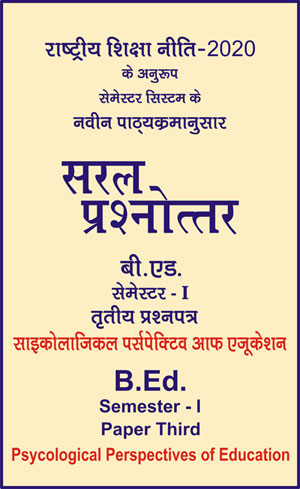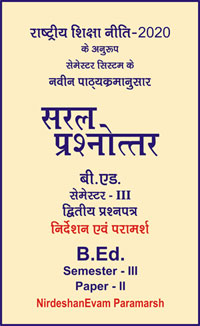|
बी एड - एम एड >> बी.एड. सेमेस्टर-1 प्रश्नपत्र-III - साइकोलाजिकल पर्सपेक्टिव आफ एजूकेशन बी.एड. सेमेस्टर-1 प्रश्नपत्र-III - साइकोलाजिकल पर्सपेक्टिव आफ एजूकेशनसरल प्रश्नोत्तर समूह
|
|
|||||||
बी.एड. सेमेस्टर-1 प्रश्नपत्र-III - साइकोलाजिकल पर्सपेक्टिव आफ एजूकेशन (अंग्रेजी भाषा में)
Question- What do you understand by theories of personality?
Or
Describe in detail trait, type and trait cum type theories.
Answer-
Theories of Personality
(i) Trait Theory of Personality : A major weakness is the element of oversimplification inherent in placing individuals into a single category, which ignores the fact that every personality represents a unique combination of qualities. Systems that address personality as a combination of qualities or dimensions are called trait theories.
Well-known trait theorist Gordon Allport (1897-1967) extensively investigated the ways in which traits combine to form normal personalities, cataloguing over 18,000 separate traits over a period of 30 years. He proposed that each person has about seven central traits that dominate his or her behavior. Allport’s attempt to make trait analysis more manageable and useful. Raymond B. Cattell reduced Allport’s extensive list to 16 fundamental groups of inter-related characteristics, and Hans Eysenck claimed that personality could be described based on three fundamental factors:
- Psychoticism
- Introversion-Extroversion
- Emotionality-Stability
Eysenck also formulated a quadrant based on intersecting emotional-stable and introverted-extroverted axes.
(ii) Type Theories : Greek physician Hippocrates, who characterized human behavior in terms of four temperaments, each associated with a different bodily fluid, or the sanguine (optimistic) type was associated with blood; the phlegmatic type with phlegm; the melancholic type (sad, depressed) with black bile; and the choleric (angry) type with yellow bile.
The theory of temperaments is among a variety of systems that deal with human personality by dividing it into types. A widely popularized (but scientifically dubious) modern typology of personality was developed in the 1940s by William Sheldon, an American psychologist. Sheldon classified personality into three categories based on body types:
- Endomorph (heavy and easy-going)
- Mesomorph (muscular and aggressive)
- Ectomorph (thin and intellectual or artistic)
The type theory represents an attempt to scientifically describe personality by classifying individuals into convenient categories.
Two categories of type theories of personality are explained below :
Sheldon Physiognomy Theory
Endomorph : He is bulky and beloved. Sheldon’s endomorph to be rather fat, thick in proportion to his height. His...personality temperament is viscerotonic (the person seeks comfort, loves fine food, eats too much, is jovial, affectionate and liked by all).
Mesomorph : He is basically strong, athletic and tough. All appreciate his physique. In fact, it is this personality all other "morphs" wish for. According to Sheldon, he will tend to be somatotonic (he is fond of muscular activity; he tends to be highly aggressive, and self-assertive).
Ectomorph : These people are thin, long and poorly developed physically. Though physically weak, he leads the league in the intelligent department.
Carl Jung Extrovert Introvert Theory
Carl jung describes two types of personality -
-
Extrovert : They are optimistic, outgoing, gregarious and sociable. Extroverts are basically objective, reality-oriented individuals who are more doers than thinkers.
-
Introvert : By contrast, introverts are more inward-directed people. They are less sociable, withdrawn and absorbed in inner life. They tend to be guided by their own ideas and philosophy.
Few people are complete introverts or extroverts, but the mixture of these two ingredients determines the kind of overall personality of an individual.
(iii) Trait - Cum - Tpe - Theory - Eysenck Theory of Personality
Type- cum- Trait Approach tries to synthesize the type and trait approaches. The Eysenck theory of personality reflects such an approach.
EYSENCK'S THEORY OF PERSONALITY While Cattell has tried to use the factor analysis technique to give some basic dimensions to personality by enumerating 16 basictraits, H.J. Eysenck a German-born British psychologist went a step further in the adopting factor analysis technique by extracting second order factors and grouping traits into definite personality types. Introversion Persistence Rigidity Subjectivity Shyness Irritability Habitual response level Specific Response level. How individual behaviour is organized and acquires the shape of a definite type is revealed by the following illustration.
According to Eysenck, there are four levels of behaviour organization:
-
At the lowest level are the specific responses. They grow out of particular responses to any single act.
-
Habitual responses form the second level and comprise similar responses of an individual, to similar situations. For instance, (a) the inability to easily strike friendships, or (b) hesitancy in talking to strangers are habitual
-
At the third level is the organization of habitual acts into traits. Behaviour acts which have similarities are said to belong to one group and are called traits. In the above example the habitual responses (a) and (b) etc., give birth to a group of traits called ‘shyness’.
-
The fourth level is the organization of these traits into a general type. Traits which are similar in nature give birth to a definite type and traits like persistence, rigidity, shyness etc., have been grouped into a type termed as Introversion. An ultimate, distinct type is obtained at this final stage. A person, can now be classified as an introvert if he has traits as described at the third level, habits and habit systems as described at the second level and responds specifically as described at the first level.
The three basic dimensions derived by Eysenck through his work are: 1. Introversion - extroversion 2. Neuroticism (emotional instability - emotional stability) 3. Psychoticism. While the high end on the first dimension introversion-extroversion includes : the highly extrovert recognized as sociable, outgoing, impulsive, optimistic and jolly people, the lower end typifies the highly introvert recognized as quit, introspective, reserved, reflective, discipline and well -ordered people. Eysenck believed that purely extroverts or purely introvert people were rarely found. The second major dimension suggested by Eysenck involves emotional instability at the lower end and emotional stability at the upper end describing people as neurotic and not neurotic. Thus, at its lower end are the persons who are moody, touch, anxious or restless and at the upper end are persons who are stable, calm, carefree, even-tempered and dependable. The third dimension is Psychoticism. The people high on this dimension tend to be solitary, insensitive, egocentric, impersonal, impulsive and opposed to accepted social norms while those scoring low are found to be more empathic and less adventurous and bold. The contribution of Esynck’s theory to describing, explaining, and predicting one's behaviour and personality are notable and worthy of praise. His theory has contributed to the study of criminology, education, aesthetics, genetics, psychopathology and political ideology.
|
|||||

 i
i 










